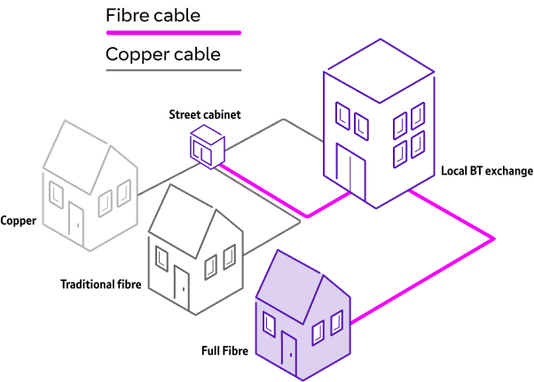As expectations and requirements for faster internet continue to grow, the conversation around broadband is shifting towards Fibre nationally. There are several different terms for Fibre and the differences in the technologies are important to understand so you can make the best decision for your business. Today, I’ll discuss the differences, advantages and plans for Fibre in the UK.
There’s 2 main types of Fibre you’ll likely hear about:
Fibre to the Cabinet
Fibre to the Cabinet (FTTC) is a form of fibre where the cabling between the telephone exchange and the cabinet are fibre, but the cabling between the cabinet and the premises are using the existing copper lines. Since FTTC uses some of the existing copper infrastructure, this means the rollout is easier as only the network between the cabinet and the exchange need upgrading, therefore making it more widespread and accessible. The available speeds depend on the line lengths but generally caps out at 76mbps.
Fibre to the Premises
Fibre to the Premises (FTTP) is often referred to as ‘Full Fibre’ as the fibre cabling continues past the cabinet, all the way to the premises. This means faster speeds can be made possible (up to 1GBps) and it doesn’t rely on any of the copper infrastructure. Available speeds will always depend on the line length, even on FTTP. The logistics behind the physical roll-out mean FTTP has far lower availability across the country as it involves end to end new connections compared to how FTTC uses the existing copper network between the premises and the cabinet. There are several companies who specialise in full fibre broadband which is helping further the rollout nationally beyond just Openreach’s plans.
Both technologies are called ‘fibre’ so it’s good to understand the difference as it can impact the speeds available. As a rule of thumb, anything clocking over 80mbps is using a ‘full fibre’ connection – below this speed, it can be either FTTC or FTTP. ADSL caps out around 20mbps so moving onto fibre is almost always an improvement on speeds.
Here is a diagram showing a simplified version of the difference in the Openreach network between a full copper (ADSL) connection, a traditional fibre (FTTC) connection and a full fibre (FTTP) connection.

Future plans and what can I get now?
As mentioned before, there are several specialist companies who run their own network for fibre. Typically, they will advertise if they’re available in your area with leaflets through the door or posters on their network equipment, but you can often check on their websites using your address. If they’re expanding to cover your area, chances are you’ll see it either in the development stages or when they begin to make people aware it’s ready to be ordered.
For any provider that uses Openreach, you can use this fibre availability checker on their website here which will advise what options are currently available. If it’s not yet ready to order, you can sign up to be notified when Ultrafast becomes available in your area. Openreach has a national fibre rollout plan in the motions to help move away from the copper infrastructure.
Here at BT Business, we use Openreach as our supplier, and have several fibre options available depending on the technology in your area. Find out more information on our website.
If you have any questions or want to discuss this further, you’re in the right place. Make a post here or send us a message and we can discuss further.
^BethM
